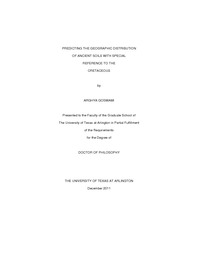
ATTENTION: The works hosted here are being migrated to a new repository that will consolidate resources, improve discoverability, and better show UTA's research impact on the global community. We will update authors as the migration progresses. Please see MavMatrix for more information.
Show simple item record
| dc.contributor.author | Goswami, Arghya | en_US |
| dc.date.accessioned | 2012-04-11T20:59:21Z | |
| dc.date.available | 2012-04-11T20:59:21Z | |
| dc.date.issued | 2012-04-11 | |
| dc.date.submitted | January 2011 | en_US |
| dc.identifier.other | DISS-11443 | en_US |
| dc.identifier.uri | http://hdl.handle.net/10106/9631 | |
| dc.description.abstract | Different kinds of soils form in different climatic regimes. Soils closely match climatic conditions. Therefore, they are one of the best indicators of past climates. This study uses the "climate envelope" technique developed by Moore (2007) to build a "paleo-soil prediction program". Though factors controlling soil formation are complex (Retallack, 1990), the best fit between a given soil type (Zobler 1999) and the annual range of rainfall and temperature (Legates and Wilmott 1990) are thought to be the primary factors. Each modern soil type has a unique climatic "fingerprint" or "climate envelope" defined by the range of rainfall and temperature values. Assuming similar types of soil formed under similar temperature-precipitation regimes in the past, paleoclimate simulations (Fast Ocean and Atmosphere Model) can be used to predict the ancient geographic distribution of different soil types.The earth's pole-to-equator temperature gradient represents a fundamental climatological property related to equator-to-pole heat transport efficiency, hydrological cycling, and atmospheric chemistry (Cronin, 2009). On the other hand, one of the major challenges of paleoclimate research is that climate models, both coupled and uncoupled ocean-atmosphere models, often underestimate the warm polar temperatures that are indicated by fossil and geochemical data (e.g., DeConto et al., 2000). To test the validity of the four Cretaceous paleoclimate simulations (Early Maastrichtian (70 Ma), Cenomanian-Turonian (90 Ma), Early Aptian (120 Ma) and Valanginian - Berriasian (140 Ma)), seven Cretaceous stages were studied by constructing detailed pole-to-equator temperature gradients based on paleotemperature estimates from plant and animal fossils, as well as isotopic data.In the final part of this study, the pole-to-equator temperature gradients derived from fossils and isotopic data and the pole-to-equator temperature gradients estimated by FOAM were compared. The FOAM temperatures were adjusted to conform to the geological evidence for the Cretaceous. With this new adjusted temperature and global precipitation data, the ancient soil prediction program was rerun for the four Cretaceous time intervals. The revised ancient soil maps are in better agreement with the geologic and climatic conditions known to have existed during the Cretaceous. | en_US |
| dc.description.sponsorship | Scotese, Christopher | en_US |
| dc.language.iso | en | en_US |
| dc.publisher | Environmental & Earth Science | en_US |
| dc.title | Predicting The Geographic Distribution Of Ancient Soils With Special Reference To The Cretaceous | en_US |
| dc.type | Ph.D. | en_US |
| dc.contributor.committeeChair | Scotese, Christopher | en_US |
| dc.degree.department | Environmental & Earth Science | en_US |
| dc.degree.discipline | Environmental & Earth Science | en_US |
| dc.degree.grantor | University of Texas at Arlington | en_US |
| dc.degree.level | doctoral | en_US |
| dc.degree.name | Ph.D. | en_US |
Files in this item
- Name:
- Goswami_uta_2502D_11443.pdf
- Size:
- 23.46Mb
- Format:
- PDF
- Name:
- Pole-to-EquatorTemperatureData ...
- Size:
- 557.5Kb
- Format:
- Microsoft Excel
- Name:
- ArcMapFiles&Data.rar
- Size:
- 78.56Mb
- Format:
- Unknown
This item appears in the following Collection(s)
Show simple item record


